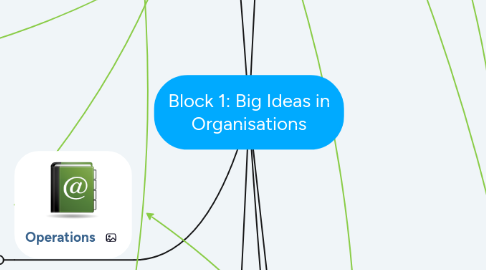
1. Innovation
1.1. Big Idea
1.2. New idea, device or process
1.3. Benefits
1.3.1. Improvement
1.3.2. Progress
1.3.3. Competitive Advantage
2. Operations
2.1. Management
2.1.1. Input-Process-Output
2.1.1.1. Transformation Processes
2.1.1.1.1. Material
2.1.1.1.2. Information
2.1.1.1.3. Customer
2.1.1.2. Transformation Changes
2.1.1.2.1. Physical
2.1.1.2.2. Informational
2.1.1.2.3. Possession
2.1.1.2.4. Location
2.1.1.2.5. Storage
2.1.1.2.6. Physiological
2.1.2. Organising Resources
2.1.3. Managing Outputs
2.1.4. Managing Processes
2.1.4.1. Design Processes
2.1.4.2. Planning/Control
2.1.4.3. Improvement
2.1.5. Hayes and Wheelwright four-stage model
2.1.5.1. Internally Neutral
2.1.5.2. Externally Neutral
2.1.5.3. Internally Supportive
2.1.5.4. Externally Supportive
2.2. Strategy
2.2.1. Decisions
2.2.1.1. Capacity and Facilities
2.2.1.2. Supply Chain Management
2.2.1.3. Technology
2.2.1.4. Workforce
2.2.2. Market Reconciliation Model
2.2.2.1. Resources Available
2.2.2.2. Requirements of Market
2.2.3. Performance Objectives
2.2.3.1. Quality
2.2.3.2. Speed
2.2.3.3. Flexibility
2.2.3.4. Sustainability
2.2.3.5. Dependability
2.2.3.6. Cost
2.2.3.7. Polar Representation
3. Economics
3.1. Cash Flow Management
3.2. Traditional Forms of Funding
3.2.1. Retained Earnings
3.2.2. Working Capital Management
3.2.3. Debt Factoring
3.2.4. Bank Overdrafts
3.2.5. Bank Facility Finances
3.2.6. Lease Finance
3.2.7. Equity Finance
3.2.7.1. Ordinary Shares
3.2.7.2. Preference Shares
3.2.8. Venture Capital/Private Equity
3.3. New (Online) forms of Funding
3.3.1. Microfinance
3.3.2. Crowdfunding
3.3.3. Peer-to-peer lending
3.4. External Environment
3.4.1. STEEPLE Analysis
3.4.1.1. Globalisation
3.4.2. Economy
3.4.2.1. Recession
3.4.2.2. Recovery
3.4.3. International Trade
3.4.3.1. Comparative Advantage
3.5. Outsourcing
3.5.1. Benefits
3.5.1.1. Reduce Costs
3.5.1.2. Improve Focus
3.5.1.3. Increase Variable Cost Element
3.5.1.4. Access to skills
3.5.1.5. Grow Revenue
3.5.1.6. Quality Improvement
3.5.1.7. Conserve Capital
3.5.1.8. Innovate
3.5.2. Risks
3.5.2.1. Distance
3.5.2.1.1. Transport Costs
3.5.2.1.2. Time Zones
3.5.2.2. Currency
3.5.2.3. Legal Systems
3.5.2.4. Political or Economic Instability
3.5.2.5. Quality and Reliability of Services
3.5.2.6. Language/Culture Barriers
3.5.2.7. Brand Damage
4. Human Resource Management
4.1. Labour Shortages
4.1.1. Hire Migrant Workers
4.1.2. Attract More Citizens
4.1.2.1. Increase Wages
4.1.2.2. Improve Working Conditions
4.1.3. Decrease Labour Intensity
4.1.3.1. Change Production Processes
4.1.3.2. Increase Technology
4.1.4. Relocate
4.2. Differences in Managing Public and Private Sector Businesses
4.2.1. Different Values
4.2.2. Misson
4.2.3. Politics
5. Marketing
5.1. Marketing Concept
5.1.1. Orientation
5.1.2. Function
5.1.2.1. Analyse Markets
5.1.2.2. Determine Objectives
5.1.2.3. Identify Customers
5.1.2.4. Manage Brand
5.1.2.5. Set Price
5.1.3. Process
5.1.3.1. Mission, Vision and Values
5.1.3.2. Market Analysis
5.1.3.3. Strategy Selection
5.1.3.4. Formulate Offering
5.1.3.5. Implementation and Evaluate
5.2. Marketing Environment
5.2.1. Micro Environment
5.2.1.1. Customers
5.2.1.2. Marketing Intermediaries
5.2.1.3. Suppliers
5.2.1.4. Public
5.2.1.5. Competitors
5.2.2. Macro Environment
5.2.2.1. Social
5.2.2.2. Technological
5.2.2.3. Economic
5.2.2.4. Environmental
5.2.2.5. Political
5.2.2.6. Legal
5.2.2.7. Ethical
5.2.3. Competitive Advantage
5.2.3.1. Cost Leadership
5.2.3.2. Differentiation
5.2.3.3. Focus
5.2.3.4. Porter's Five Forces
5.2.4. Ansoff's Growth Matrix
5.3. Marketing Research
5.3.1. Process
5.3.1.1. Planning
5.3.1.2. Exploratory Research
5.3.1.3. Refining Research Design
5.3.1.4. Collecting Data
5.3.1.5. Analysis Data
5.3.1.6. Report Findings
5.3.2. Ethics
5.3.2.1. Data Protection
5.4. Focusing an Offering
5.4.1. Markets
5.4.2. Segmentation
5.4.2.1. Demographic
5.4.2.2. Geographic
5.4.2.3. Psychographic
5.4.2.4. Behavioural
5.4.2.5. Defra's Seven Population Segments
5.4.3. Targeting
5.4.3.1. Undifferentiated
5.4.3.2. Differentiated
5.4.3.3. Concentrated
5.4.3.4. Customised
5.4.4. Positioning
5.4.4.1. Clarity
5.4.4.2. Consistency
5.4.4.3. Credibility
5.4.4.4. Competitiveness
5.5. Marketing Mix
5.5.1. Product
5.5.1.1. Levels of Product
5.5.1.2. Types of Product
5.5.1.3. Developing
5.5.2. Place
5.5.2.1. Distribution Channels
5.5.3. Promotion
5.5.3.1. Communication Process
5.5.4. Pricing
5.5.4.1. Cost Based
5.5.4.2. Competitor Based
5.5.4.3. Customer Based
5.5.5. Services
5.5.5.1. People
5.5.5.2. Processes
5.5.5.3. Physical Evidence
6. Design
6.1. New Product Development
6.1.1. Enhancement
6.1.2. New Generation
6.1.3. Breakthrough
6.2. Design Process
6.2.1. Discover
6.2.2. Define
6.2.3. Develop
6.2.4. Deliver
6.3. Design Thinking
6.3.1. Reframe Ideas
6.3.2. See the Bigger Picture
6.3.3. Understand the User
6.3.4. No Idea is too Wild
6.3.5. Collaborate
6.3.6. Test your Ideas
6.4. QFD Matrix
6.4.1. What?
6.4.2. How?
6.4.3. What Vs How
6.4.4. Conflicts
6.4.5. Why?
6.4.6. Level (How Much?)
6.5. Product Design
6.5.1. Aesthetics
6.5.2. Reliability
6.5.3. Maintainability
6.5.4. Durability
6.5.5. Produce-ability
6.6. Service Design
6.6.1. The Organising Idea
6.6.2. The Service Experience
6.6.3. The Service Outcome
6.6.4. The Service Operation
6.6.5. Value of Service
6.7. Process Design
6.7.1. Understanding Design Factors
6.7.1.1. Volume
6.7.1.2. Variety
6.7.1.3. Variation (Demand)
6.7.1.4. Visibility
6.7.2. Process Choice
6.7.2.1. Manufacturing
6.7.2.1.1. Project
6.7.2.1.2. Jobbing
6.7.2.1.3. Batch
6.7.2.1.4. Mass
6.7.2.1.5. Continuous
6.7.2.2. Services
6.7.2.2.1. Professional
6.7.2.2.2. Service Shops
6.7.2.2.3. Mass
6.7.3. Layout Choice
6.7.3.1. Fixed Position
6.7.3.2. Functional
6.7.3.3. Product
6.7.3.4. Mixed/Hybrid
6.7.3.5. Volume And Variety
6.7.4. Detailed Design

